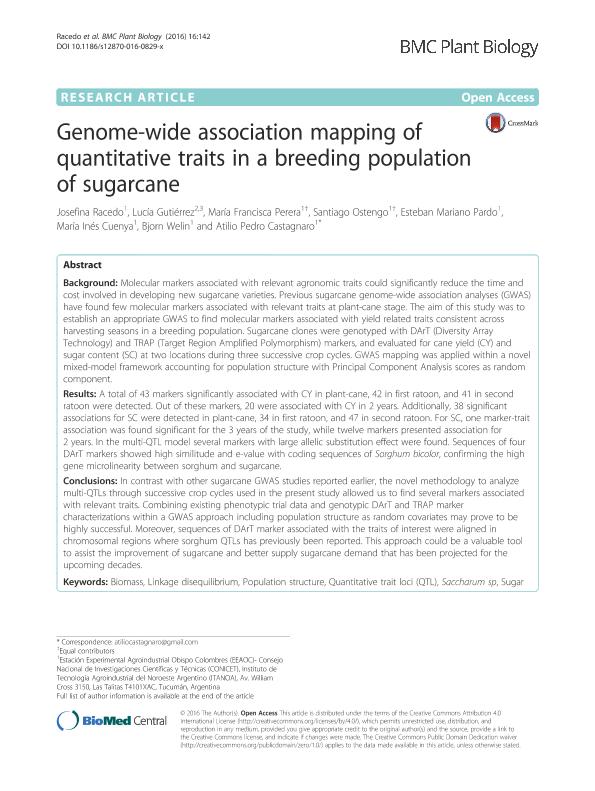Artículo
Genome-wide association mapping of quantitative traits in a breeding population of sugarcane
Racedo, Josefina ; Gutierrez, Lucía; Perera, María Francisca
; Gutierrez, Lucía; Perera, María Francisca ; Ostengo, Santiago; Pardo, Esteban Mariano; Cuenya, María Inés
; Ostengo, Santiago; Pardo, Esteban Mariano; Cuenya, María Inés ; Welin, Bjorn
; Welin, Bjorn ; Castagnaro, Atilio Pedro
; Castagnaro, Atilio Pedro
 ; Gutierrez, Lucía; Perera, María Francisca
; Gutierrez, Lucía; Perera, María Francisca ; Ostengo, Santiago; Pardo, Esteban Mariano; Cuenya, María Inés
; Ostengo, Santiago; Pardo, Esteban Mariano; Cuenya, María Inés ; Welin, Bjorn
; Welin, Bjorn ; Castagnaro, Atilio Pedro
; Castagnaro, Atilio Pedro
Fecha de publicación:
06/2016
Editorial:
BioMed Central
Revista:
BMC Plant Biology
ISSN:
1471-2229
Idioma:
Inglés
Tipo de recurso:
Artículo publicado
Clasificación temática:
Resumen
Background: Molecular markers associated with relevant agronomic traits could significantly reduce the time and cost involved in developing new sugarcane varieties. Previous sugarcane genome-wide association analyses (GWAS) have found few molecular markers associated with relevant traits at plant-cane stage. The aim of this study was to establish an appropriate GWAS to find molecular markers associated with yield related traits consistent across harvesting seasons in a breeding population. Sugarcane clones were genotyped with DArT (Diversity Array Technology) and TRAP (Target Region Amplified Polymorphism) markers, and evaluated for cane yield (CY) and sugar content (SC) at two locations during three successive crop cycles. GWAS mapping was applied within a novel mixed-model framework accounting for population structure with Principal Component Analysis scores as random component. Results: A total of 43 markers significantly associated with CY in plant-cane, 42 in first ratoon, and 41 in second ratoon were detected. Out of these markers, 20 were associated with CY in 2 years. Additionally, 38 significant associations for SC were detected in plant-cane, 34 in first ratoon, and 47 in second ratoon. For SC, one marker-trait association was found significant for the 3 years of the study, while twelve markers presented association for 2 years. In the multi-QTL model several markers with large allelic substitution effect were found. Sequences of four DArT markers showed high similitude and e-value with coding sequences of Sorghum bicolor, confirming the high gene microlinearity between sorghum and sugarcane. Conclusions: In contrast with other sugarcane GWAS studies reported earlier, the novel methodology to analyze multi-QTLs through successive crop cycles used in the present study allowed us to find several markers associated with relevant traits. Combining existing phenotypic trial data and genotypic DArT and TRAP marker characterizations within a GWAS approach including population structure as random covariates may prove to be highly successful. Moreover, sequences of DArT marker associated with the traits of interest were aligned in chromosomal regions where sorghum QTLs has previously been reported. This approach could be a valuable tool to assist the improvement of sugarcane and better supply sugarcane demand that has been projected for the upcoming decades.
Archivos asociados
Licencia
Identificadores
Colecciones
Articulos(ITA-NOA)
Articulos de INST. DE TECNOLOG. AGROINDUST. DEL NOROESTE ARGENTINO
Articulos de INST. DE TECNOLOG. AGROINDUST. DEL NOROESTE ARGENTINO
Citación
Racedo, Josefina; Gutierrez, Lucía; Perera, María Francisca; Ostengo, Santiago; Pardo, Esteban Mariano; et al.; Genome-wide association mapping of quantitative traits in a breeding population of sugarcane; BioMed Central; BMC Plant Biology; 16; 142; 6-2016; 1-12
Compartir
Altmétricas



